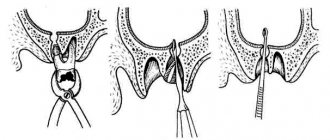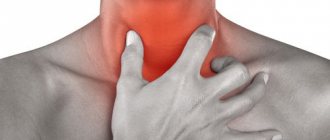Prices for services You can look at the price list or check by calling the phone number listed on the website.
The article was checked by an otorhinolaryngologist, Ph.D. Dubtsova E.A. , is for general informational purposes only and does not replace specialist advice. For recommendations on diagnosis and treatment, consultation with a doctor is necessary.
Throat diseases unite a whole group of diseases localized in the pharynx, larynx, tonsils, soft palate and palatine arches.
- At the Yauza Clinical Hospital, the diagnosis and treatment of all these diseases is carried out by specialists from the otolaryngology department - experienced doctors of the highest qualification category.
- To make an accurate diagnosis, after collecting an anamnesis and a medical examination, the necessary laboratory tests are carried out (general blood and urine tests, virological or bacteriological examination of a smear, etc.).
- The capabilities of our hospital allow us to carry out all studies in the shortest possible time and begin treatment immediately.
- 1st place in the structure of ENT diseases is occupied by diseases of the pharynx (primarily chronic pharyngitis and tonsillitis), 4th place by pathology of the larynx
- With a general weakening of the body and the absence of proper treatment, diseases can become chronic, worsening a person’s quality of life.
- Diseases of the ENT organs can lead to various complications. Considering this, it is difficult to overestimate the importance of timely contact with specialists
Sign up for a consultation
Throat diseases are a broad group of various pathological conditions, combining both acute and chronic throat diseases. Based on their origin, they are usually divided into infectious and non-infectious. Most ENT diseases of the throat are caused by viruses and bacteria that enter the mucous membrane from the outside. The wide prevalence of this pathology is associated with the structural features of the throat, which is the body’s first line of defense and always takes the brunt of infection.
The most common throat diseases:
- adenoids;
- pharyngitis;
- tumors of the larynx and oropharynx;
- laryngitis;
- peritonsillar abscess;
- tonsillitis;
- snore;
Most diseases are characterized by an acute onset with a significant deterioration in well-being. The main danger is that, if left untreated, the disease can become chronic and can also provoke the development of various complications - cardiovascular pathology, diseases of the paranasal sinuses, lungs, joints, and kidneys.
It is not customary to pay much attention to throat diseases. Many people try to treat them at home. This leads to the development of chronic forms of throat diseases. Do not self-medicate. Make an appointment with a doctor, get professional help and adequate therapy.
Symptoms of throat diseases
Most throat diseases have pronounced symptoms. Moreover, the clinical picture for each disease is individual. Among the common and most basic symptoms it is worth highlighting:
- sore throat that gets worse when swallowing;
- sore throat, dry throat;
- cough;
- hoarseness of voice;
- temperature increase;
- enlargement of the submandibular and cervical lymph nodes;
- weakness and general malaise;
- headache;
- bad breath.
The combination of several of these symptoms at once is a reason to immediately consult a doctor. If symptoms increase and health deteriorates, prompt medical care is necessary.
Some throat diseases can cause rapid swelling of the larynx. As a result, without medical assistance, the patient can quickly die from suffocation. If you experience pain, immediately make an appointment with a doctor. This will help quickly and effectively eliminate the disease.
How is the feeling of a lump in the throat treated?
Treatment is determined by the causes and mechanism of development of the disease and is selected individually for each patient.
For a recent and non-severe condition
treatment is carried out on an outpatient basis: the doctor conducts a psychotherapeutic session, prescribes medications that the patient takes at home and periodically comes for follow-up consultations.
For moderate severity
- treatment in a day hospital is recommended: daily treatment procedures are carried out (drug infusions, physiotherapy, etc.), which take an hour and a half, but the patient lives at home and goes about his usual business. The average course of a day hospital is about 10 days.
In severe condition
hospitalization in a hospital is recommended. Due to intensive treatment, the condition can be stabilized already in the first hours of stay. The average length of hospital stay is 10 days (from 5 to 30 days depending on the severity of the condition and the body’s recovery abilities).
Main methods of treatment:
- Psychotherapy.
- Drug treatment (pharmacotherapy).
- Physiotherapy.
- Massage and manual therapy.
- Diet therapy.
- Biofeedback therapy.
Causes of disease development
Acute and chronic throat diseases can occur for various reasons, among the most common are:
- microorganisms (bacteria, viruses, fungi);
- gastroesophageal reflux disease (GERD);
- allergens;
- adverse environmental impacts;
- voice overstrain;
- injuries;
- hypothermia;
- general decrease in immunity;
- smoking.
A combination of several reasons is possible. Their identification and elimination is an integral part of treatment.
Signs and causes
Most diseases of the throat and larynx are infectious in nature. The causative agents are bacteria, viruses and fungi.
The most common bacterial
throat disease - sore throat. Its appearance is caused by streptococci, chlamydia, mycoplasmas, gonococci and tubercle bacilli. Scarlet fever, diphtheria and epiglottitis are also caused by bacteria. All three diseases are manifested by a sore throat, and epiglottitis is generally life-threatening as it can lead to airway obstruction.
Symptoms of bacterial diseases:
- general weakness;
- swelling of the larynx, tonsils;
- high body temperature;
- pain and discomfort in the throat.
For viral
diseases, a sore throat can be one of the symptoms of an illness, for example, ARVI, influenza or measles. Infectious mononucleosis caused by the Epstein-Barr virus (herpes type IV) stands apart. Its development is dangerous due to the rapid spread of inflammation to the spleen and liver, which in turn leads to enlargement of the lymph nodes.
Viral diseases are similar in symptoms:
- heat;
- prostration;
- headache;
- general weakness;
- runny nose;
- cough;
- rash;
- pain and sore throat.
Fungal diseases
genesis - a consequence of the active activity of yeast-like fungi, which looks like a cheesy mass on the mucous membrane during tonsillitis or pharyngitis. Symptoms of a fungal infection of the throat:
- severe sore throat;
- the temperature remains normal.
Fungi quickly multiply in the body during disorders of the gastrointestinal tract, against the background of vitamin deficiency, abuse of antibiotics and hormonal drugs.
A special place as a cause of pain in the throat and larynx is occupied by tumors. It can be primary, that is, formed for the first time, or it can be secondary, the result of metastasis of oncological processes in other parts and organs of the body. The larger the tumor, the more discomfort it brings: the voice changes, becoming hoarse, a feeling of a lump appears in the throat, and it becomes difficult to swallow.
The most common throat diseases
Among the most common diseases of the ENT organs in this area are pharyngitis, laryngitis and tonsillitis.
Pharyngitis
Pharyngitis is an infection of the mucous membrane of the pharynx and lymph nodes. As a rule, pharyngitis occurs against the background of an acute inflammatory disease of the upper respiratory tract. More often, pharyngitis is caused by viral-bacterial flora or fungal infection; other causes include injuries and allergic reactions. With prolonged inflammation of the pharyngeal mucosa, the disease can become chronic. Frequent colds, pathology of the gastrointestinal tract, smoking, drinking alcohol, exposure to chemicals and living in unfavorable environmental conditions can contribute to this. Exacerbation of chronic pharyngitis can be facilitated by other infectious diseases, decreased immunity, hypothermia, stress, and increased physical activity.
The main symptom of pharyngitis is pain when swallowing. The disease may also be accompanied by dryness, burning, itching, general weakness and headaches. Pharyngitis is dangerous because the infection from the pharynx can move to the middle ear and cause deterioration and even hearing loss, or go down to the larynx and cause laryngitis and tracheitis.
Laryngitis
Laryngitis is an inflammatory process of the mucous membrane of the larynx. It can occur either independently or against the background of other inflammations of the nasopharynx. There are catarrhal and phlegmonous forms. The first is characterized by the spread of inflammation only to the mucous membrane of the larynx, the second - to the submucosal layer, ligaments and muscle tissue. Laryngitis can be triggered by hypothermia, contact with people with ARVI, inhalation of irritants, smoking (including hookahs and electronic cigarettes - steam generators).
A distinctive symptom of laryngitis, in addition to changes in voice, is a “barking” cough that irritates the throat. Just like other similar throat diseases, hoarseness is a characteristic symptom here; pain when swallowing, difficulty breathing, and inflammation of the lymph nodes may also be present. Among the most serious complications of laryngitis are infiltration of the epiglottis, abscess, damage to the vocal cords, up to complete loss of voice.
Angina
Sore throat is an acute infectious disease characterized by damage to the tonsils, which is caused by viruses, bacteria or fungi. In this case, pathogens can either enter the body from the outside or already be in the body and become activated when immunity decreases. A sore throat begins acutely with a sharp deterioration in well-being and an increase in body temperature to 38-39° C. It is important not to confuse this with a common cold. A sore throat is characterized by severe sore throat, swollen lymph nodes and aching joints. When examining the patient, pustules are observed on the tonsils.
If you suspect a sore throat, you should immediately consult a doctor, because improper treatment is fraught with the development of complications in the form of abscess, otitis, meningitis, sepsis and many other life-threatening conditions.
Types of pain
“Anything can hurt: the back wall of the pharynx, the tonsils, the hypopharynx, the nasopharynx, the epiglottis with the root of the tongue,” says Vladimir Zaitsev. The main thing is to understand that there is a difference in sensations with one or another localization of pathogenic microorganisms.
1. Pain worsens when swallowing
One of the options for soreness in the throat area is pain, which intensifies when swallowing. At the same time, it is not sharp, diffuse, but intensifies when swallowed and swallowed. Here doctors usually talk about the most common situation: acute pharyngitis. “When a person became hypothermic, the back wall of the throat became cold, and it became inflamed. At the same time, there is no mucus flowing down the back wall, the throat just hurts,” notes the ENT doctor. You can go to the mirror, shine it with a flashlight and see redness on the back wall. And it will also be spilled all over the back wall.
Article on the topic
Throat hazard. Why does laryngeal cancer develop?
Here it is worth understanding, the otolaryngologist emphasizes, that if a person ignores this situation and does not begin to be treated, then the disease may progress to the chronic stage. “In this case, the pain will also change its character: instead of acute pain when swallowing, there will be a feeling of dryness of the back wall, its complete dryness, then there will be a feeling of rawness, soreness, burning, and there may be a desire to drink something or even put oil drops in the nose, to soften the wall of the pharynx,” says Vladimir Zaitsev. He emphasizes that the condition cannot be ignored. You can also see that the mucous membrane is suffering from dryness by looking in the mirror: it will be noticeable that it is not filled with water.
2. Sore throat is associated with the nose
Another type of pain appears when, for example, the tonsils are removed, or if a person has problems with the nose that lead to sleep apnea, snoring and the fact that his mouth is constantly open during sleep. “Such a situation will sooner or later lead to subatrophic pharyngitis. Due to the constant drying of the back wall of the pharynx, the mucous membrane will stop working as it should,” says Vladimir Zaitsev.
It makes noise, itches, it doesn't breathe. Non-serious symptoms of serious ENT diseases Read more
3. Aching pain on the right and left
There may also be a problem when there is bad breath, weakness, lethargy and an aching sore throat, discomfort in the throat. This is what the condition of chronic tonsillitis or exacerbation of chronic tonsillitis looks like. “When there is a history of it, pain and discomfort do not appear in the center of the pharynx, but the pain will be localized on the sides: on the right and left. Also, against the background of such pain, low-grade fever appears: its values rise to 37.3-37.5 degrees. At the same time, plugs in the tonsils will be visible, such small white curdled grains,” notes Vladimir Zaitsev.
Article on the topic
Viral throat infections: symptoms, treatment
4. Throat hurts sharply and constantly
If the pain in the throat is unbearable and sharp, the temperature jumps above 38.5, and a scarlet throat is visible, very painful, then with a high degree of probability we are talking about acute catarrhal sore throat. “The temperature is high, the pain is very strong, sometimes it doesn’t even allow you to swallow saliva, as a result of which it just starts flowing from the mouth, it even gets to this point,” says the otolaryngologist.
5. Pain in the neck area
When hoarseness appears, this indicates that the inflammation has moved from the oropharynx just below, to the larynx, says the ENT doctor. “When there is acute inflammation of the larynx, acute laryngitis develops. However, it will not necessarily be accompanied by a complete absence of voice (aphonia); dysphonia may also be present. Here, too, against the background of incomplete closure of the ligaments, pain will appear. But it will not be localized at the level of the palate or along the back wall of the pharynx. It will be marked slightly lower, at neck level. The person himself will even point to his neck, describing his condition,” says Vladimir Zaitsev. Laryngitis, as the otorhinolaryngologist emphasizes, can be subacute, acute and chronic.
And it definitely needs to be treated. “If laryngitis is not treated, the inflammation may go away, but hoarseness may remain. The vocal cords will get stuck in this state, settle down, and the person will continue to live with this hoarseness forever,” says the specialist.
Killer bones, melted plasticine. How to kill foreign bodies in the throat and ear Read more
6. Pain in the epiglottis area with suffocation
“The epiglottis is a kind of flap, a petal that closes the entrance to the trachea, and, for example, when taking a sip of water or swallowing food, it protects the organ from water and food entering further into the trachea, lungs and bronchi,” notes the doctor. At the same time, there are situations when this well-coordinated system fails. This could be:
- against the background of decreased immunity;
- during extreme heat;
- in case of injury.
In all these cases, the epiglottis can become inflamed and noticeably increase in size. “Here a characteristic pain appears, which cannot be confused with anything: suffocation, squeezing pain not at the level of the oropharynx, but slightly below, there is a feeling of lack of air. This is a bright moment, it’s called epiglottitis,” says Vladimir Zaitsev. In an acute situation, they say that the epiglottis increases in size, swells, is tense and red; naturally, therapy is required, usually with antibiotics.
There is also a situation when an abscess of the epiglottis develops: this is already a purulent process, when opening of the formation and its cleaning is required.
Article on the topic
Mushroom place. How to get rid of mycoses in the throat and ears?
7. The root of the tongue hurts
There is also such an option as inflammation of the root of the tongue. There is a lingual tonsil on it, notes the otorhinolaryngologist, which is part of the lymphoid tissue. The root of the tongue may become inflamed on its own. A lingual sore throat develops. “The temperature is as high as with a sore throat, but a person reflexively feels pain at the level of the tongue, but not at the tip or from the sides, but in the very depths. A feeling of suffocation may also develop because the airways are nearby,” says Vladimir Zaitsev.
It is also worth remembering that there is a condition when it is not so much pain that develops, but a burning sensation, itching, a desire to scratch, and there may also be slight soreness. In such a situation, notes Vladimir Zaitsev, they talk about pharyngomycosis, that is, a fungus in the throat.
Treatment of diseases of the throat and larynx
For any form of the disease, frequent and abundant drinking and rinsing is recommended; this allows you to “wash away” the waste products of viruses and bacteria, relieve inflammation and maintain the mucous membrane in the desired shape (it tends to dry out due to high body temperature during illness).
Most cases respond well to drug treatment if it is started on time. Surgical intervention is sought when purulent or tumor processes begin, that is, the disease takes on a severe form, threatening the patient’s life with suffocation.
What and how to treat:
- ARVI is the most common throat disease. It is characterized by dry throat, sore throat, runny nose, sneezing and coughing. The temperature usually stays between 37–38 degrees. Treated with antiviral drugs based on existing symptoms. Gargling with infusions of chamomile, sage and herbal lozenges helps with sore throat; they relieve irritation and make the treatment pleasantly tasty. Along with this, it is recommended to take vitamin C to support and strengthen the immune system, as well as plenty of warm drinks (herbal teas with honey are welcome);
- tonsillitis is an infectious-allergic disease that mainly affects the tonsils. It is characterized by high body temperature, up to 40 degrees, and unbearable pain in the throat. The larynx and tonsils are red - a sure sign of an inflammatory process - and have a white coating. High fever is accompanied by aching joints and headache. Treatment is prescribed by a doctor, since it is important to prevent complications. Drinking plenty of fluids, gargling with antiseptic herbs, and herbal lozenges help with a sore throat. Food should be taken pureed and liquid, not hot, so as not to injure damaged areas of the mucous membrane;
- pharyngitis is an acute inflammatory process in the pharynx, with a characteristic dry cough, soreness, stabbing pain, a feeling of a lump and inflammation in the mucous membrane, developing into purulent processes. During illness, all solid, spicy, sour and hot foods are excluded from the patient’s diet. Treatment is medicinal, the doctor prescribes antiseptics, since the disease is inflammatory in nature. Self-medication in this case is strictly prohibited: the disease develops quickly and becomes chronic;
- laryngitis - inflammation of the vocal cords and larynx is characterized by a barking cough with sputum, a hoarse voice until its complete disappearance, and a scratching pain in the throat. Children often suffer from laryngitis. Laryngitis causes swelling of the throat when lying down, which can lead to suffocation. Therefore, if you find that your child begins to choke while lying in bed, call an ambulance, lift the child to an upright position and take him to the bathroom, under a warm shower, to relieve the spasm. Laryngitis is treated with inhalations, warm compresses, warm drinks and silence. To alleviate the patient's condition, high humidity is needed in the room: a container of water, a diffuser or a wet towel on a radiator;
- Tonsillitis is an inflammation of the tonsils, which is characterized by high body temperature, acute sore throat, and bad breath due to purulent plaque on the tonsils. The main causes of tonsillitis are viruses and bacteria. The course of treatment includes gargling with a solution of soda and salt - it acts as an antiseptic and “washes away” the pus.
Bacterial throat diseases develop very quickly, within a few hours. Viral ones - a little slower. But only a doctor can determine the real etiology of the disease, and then only based on test results.
Prevention
It is impossible to ensure that your throat never hurts, especially in the autumn-winter period. But prevention can be carried out regularly to reduce the risk of illness and strengthen the immune system. For this:
- stop smoking if you smoke - nicotine irritates and dries out the mucous membrane of the nose and throat, making them vulnerable to pathogens;
- eat a varied and nutritious diet so that the body receives vitamins and minerals in full;
- humidify the indoor air - artificial indoor fountains, aquariums, diffusers, and water containers are suitable for this. Too dry air is a strong irritant to the throat and contributes to the appearance of microtraumas on the mucous membrane;
- wash your hands more often - pathogenic bacteria, as a rule, enter our body from dirty hands;
- take vitamins - they support the immune system;
- dress according to the weather - during hypothermia, blood vessels narrow, which destroys the protective mechanism of the mucous membrane and the person catches a cold. The cold itself does not contribute to this;
- do not self-medicate - there is a high risk of complications, for example, in the form of hearing loss or disease of the ears, lungs, eyes or brain.
If you feel unwell, consult a doctor. You can make an appointment with a multidisciplinary medical otolaryngologist using the feedback form or by calling.









